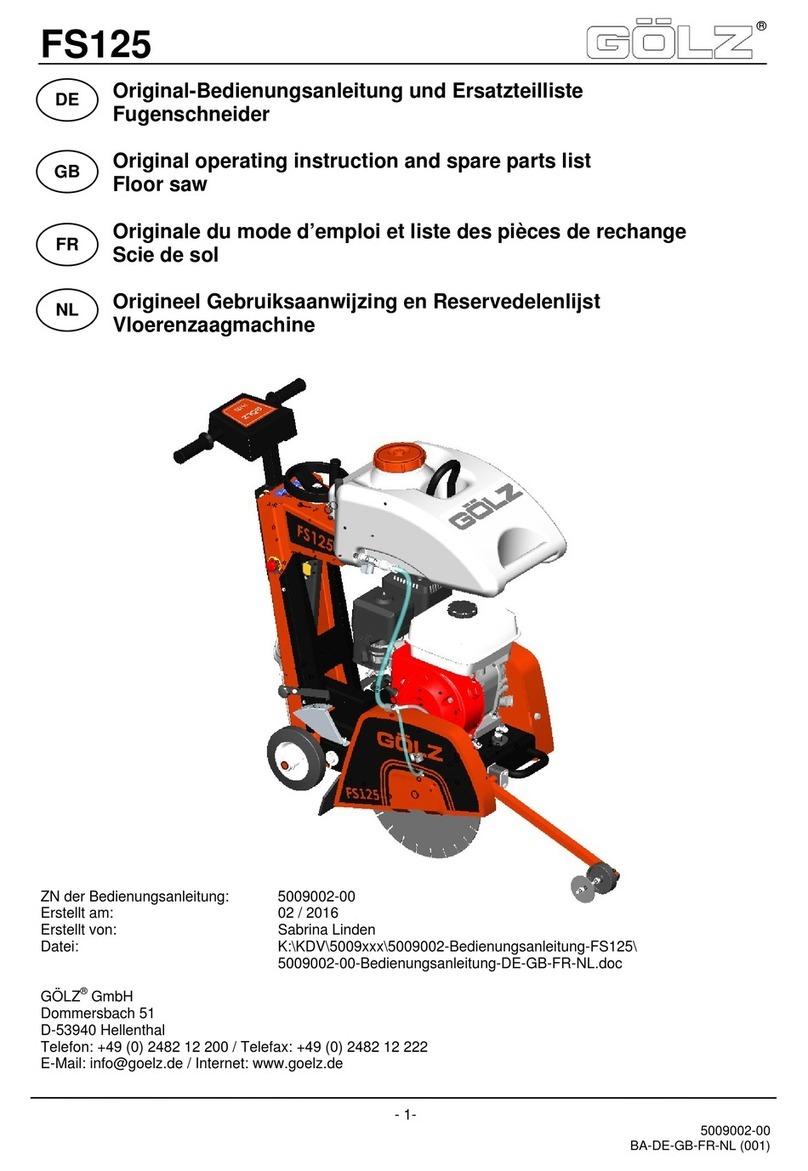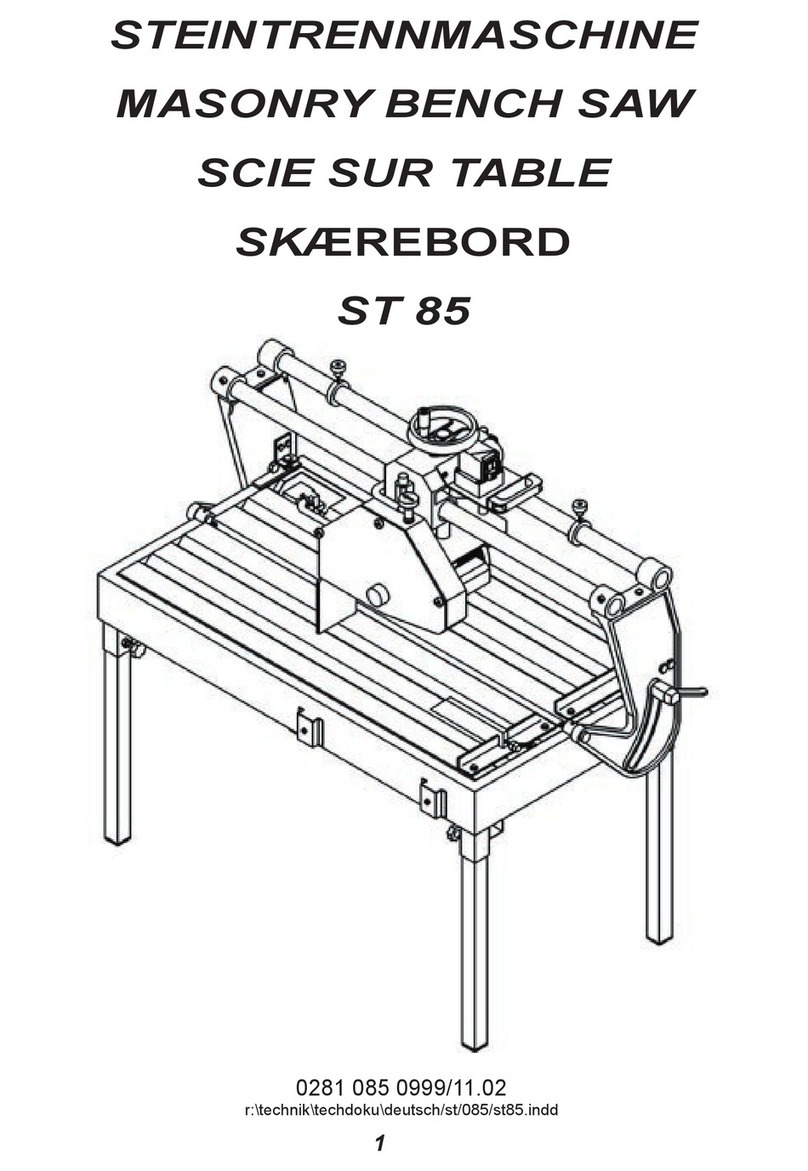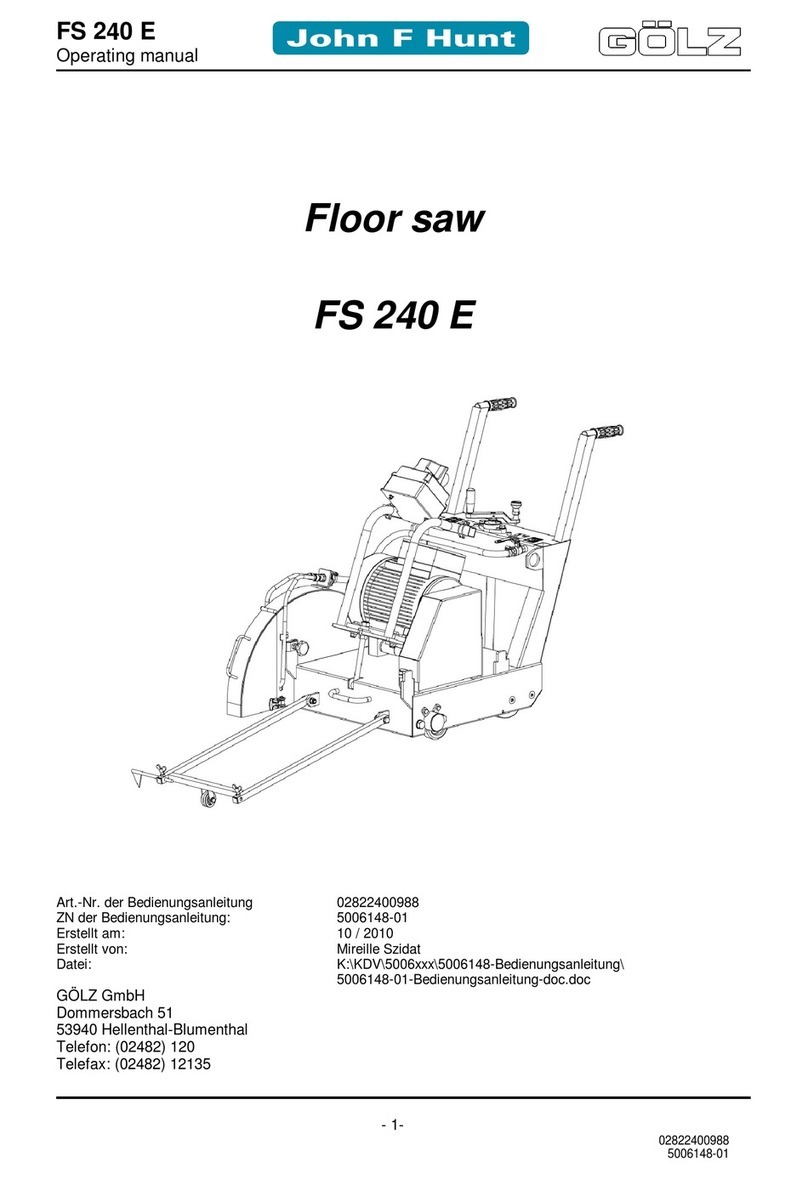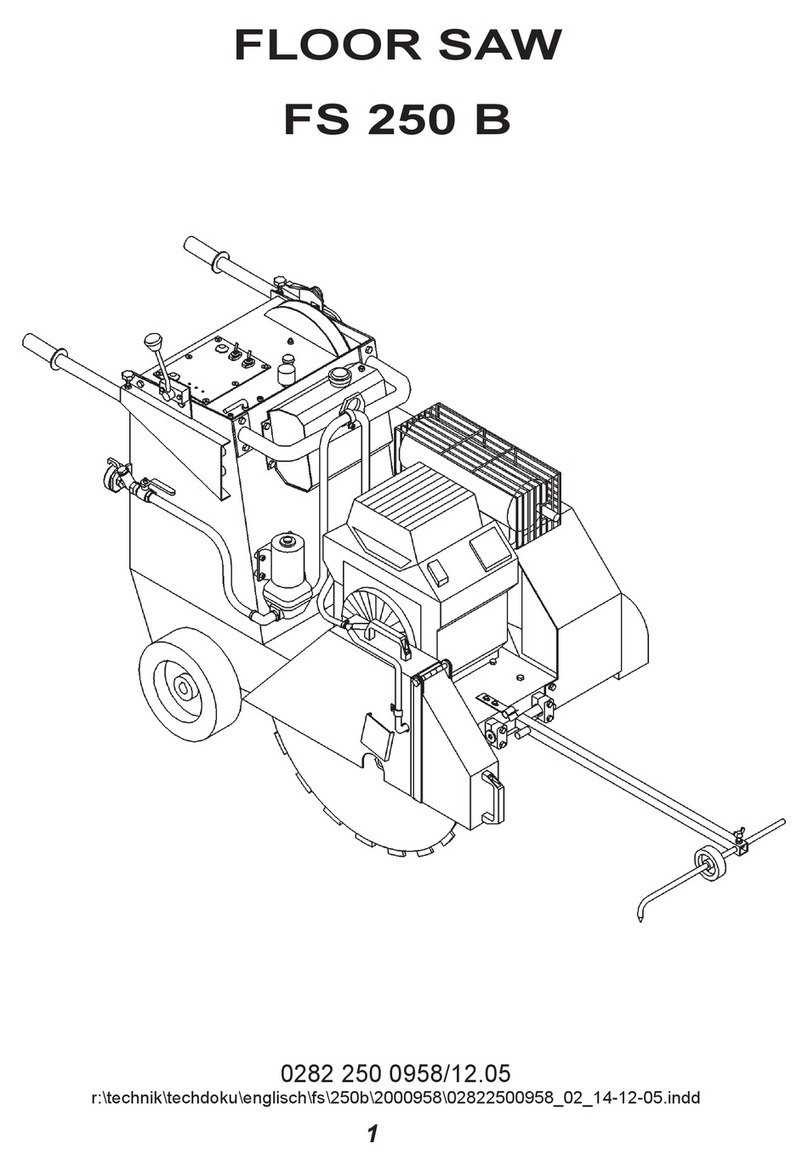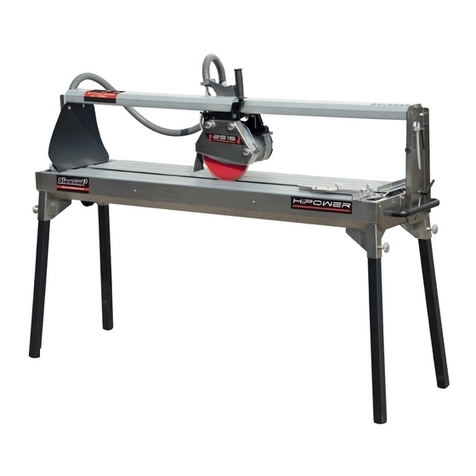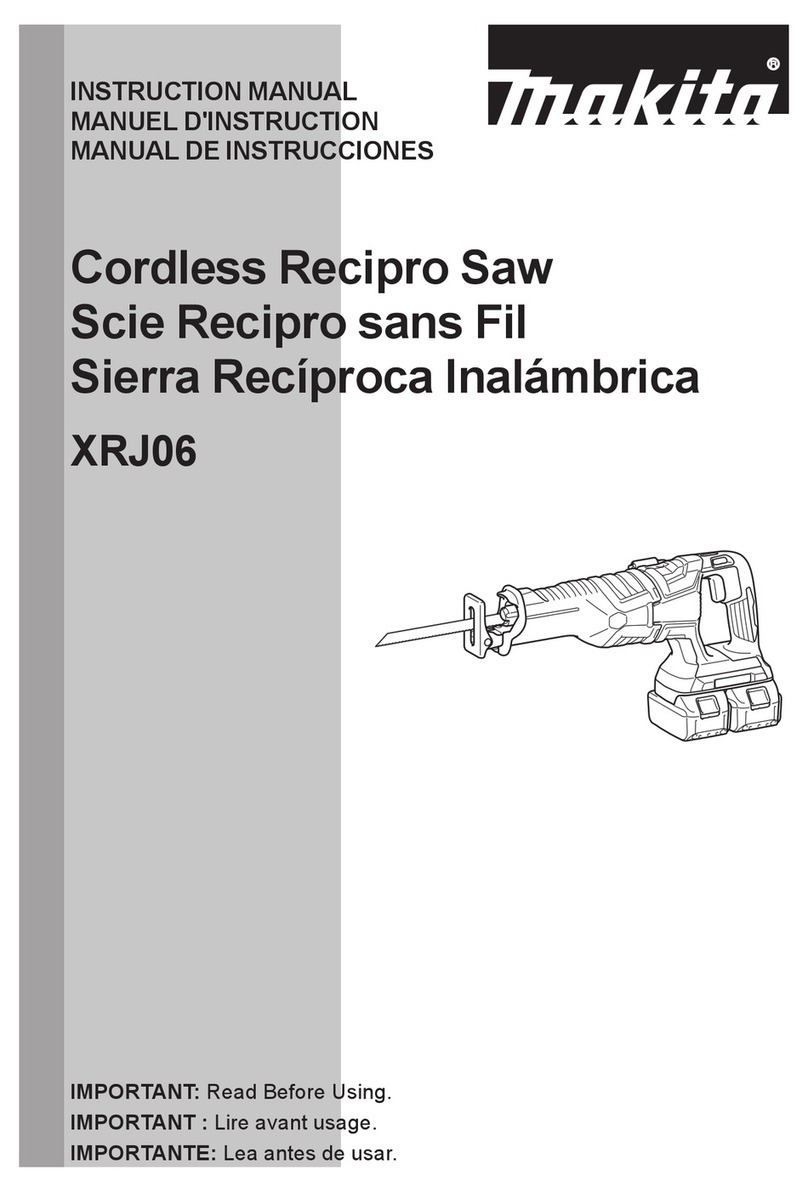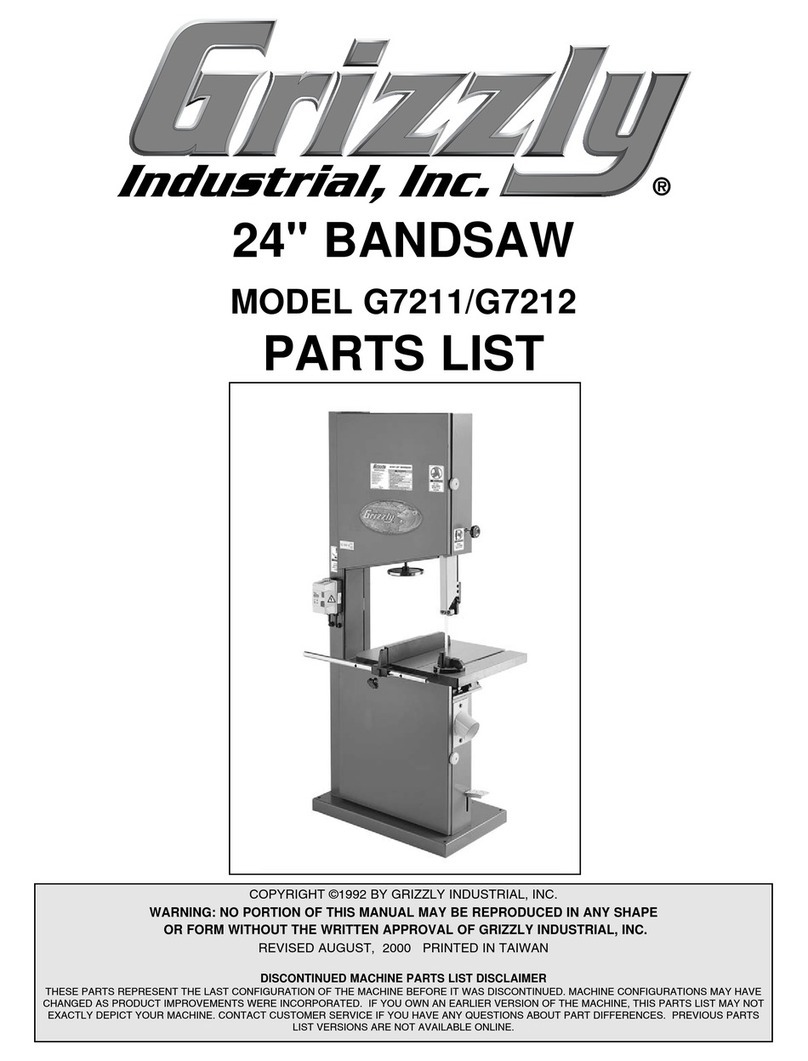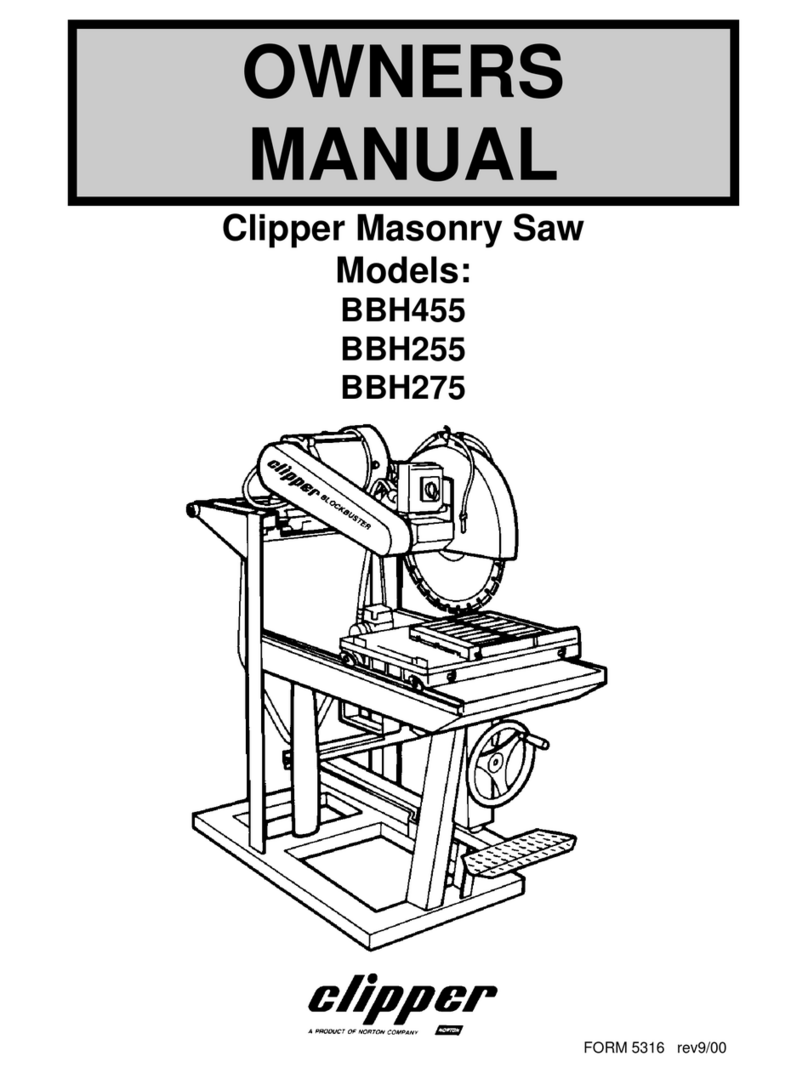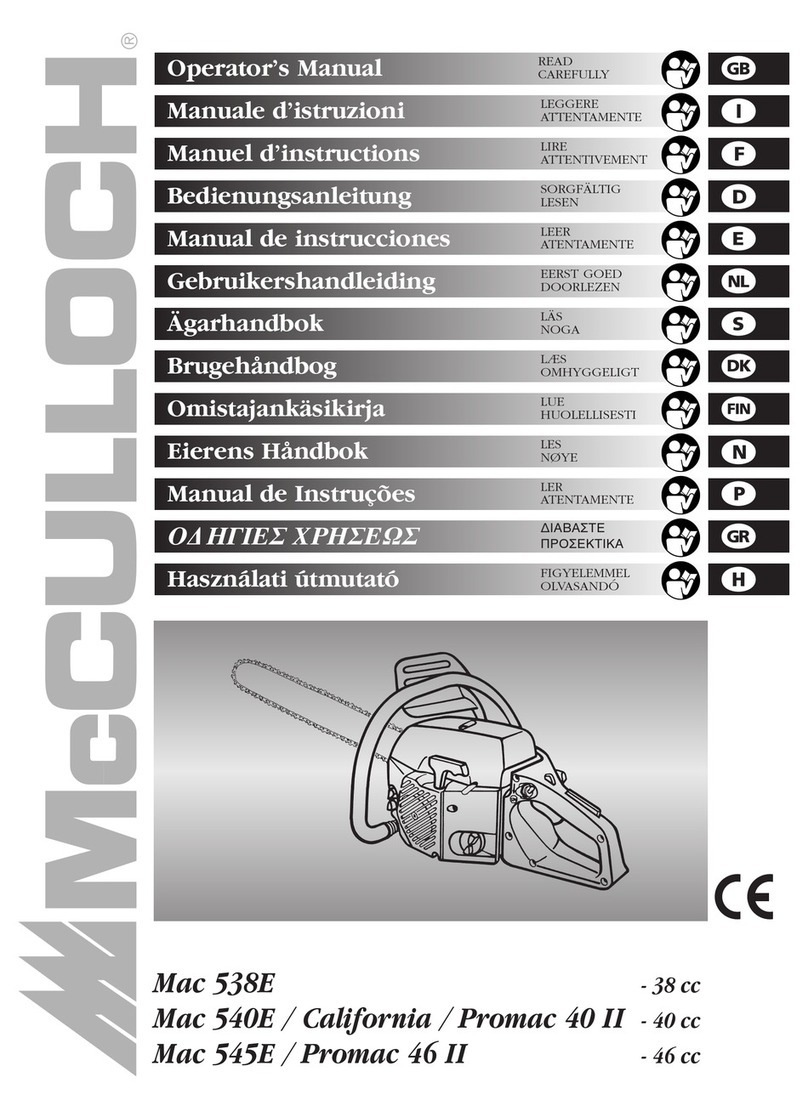GÖLZ FS 170 User manual

1
FS 130 - FS 170
FLOOR SAW
0282 170 0989/05.05
r:\technik\techdoku\englisch\fs\130-170\02821700989.indd

2
FS 130 /FS170

3
GÖLZ
GmbH
Dommersbach 51
D-53940 Hellenthal-Blumenthal
Phone: (02482) 120
Telefax: (02482) 12135
May, 14th 2003
We declare, the product
Name:
FLOOR SAW
Manufacturer:
GÖLZ
Type:
FS 130 - FS 170
Serial number: __________
is in conformity with the Directives
- 98/37/EC
- 89/336/EWG i.d.F. 93/68/EWG
- 97/68/EC i.d.F. 2002/88/EC
- 2000/14/EC
as well as with the standards
- EN 13862:2001
- EN 13309:2000; EN 61000
- EN ISO 3744:1995
..................................
Chief designer
CE-Declaration of Conformity

4
FS 130 /FS170
All rights reserved!
We endeavour continuously to improve the quality of our products and adapt them to the
highest technical standards. The text and figures in this operating instruction can therefore
differ from your equipment.
© Copyright
GÖLZ GmbH
Contents
1. Basic informations............................................... 5
2. Fundamental safety instructions........................ 5
3. Description............................................................ 9
4. Transport............................................................. 13
5. Installation and operation.................................. 13
6. Maintenance........................................................ 17
7. Troubleshooting ................................................. 19
8. Safety checks on electrical systems................21
9. Spare parts list.................................................... 23

5
1. Basic informations
Thanks for choosing a
GÖLZ
-product. This operating instruction is designed to familiarize the user with the
machine and its designated use.
The operating instruction contains important information on how to operate the machine safely, properly and
most efficiently. Observing these instructions helps to avoid danger, to reduce repair costs and downtimes and
to increase the reliability and life of the machine.
The operating instruction is to be supplemented by the respective national rules and regulations for accident
prevention and environmental protection. The operating instruction must always be available wherever the
machine is in use.
This operating instruction must be read and applied by any person in charge of work with or on the machine,
such as:
- Operation including setting up, troubleshooting in the course of work, evacuation care and disposal
of fuels and consumables.
- Maintenance (servicing, inspection, repair) and/or
- Transport
In addition to the operating instructions and to the mandatory rules and regulations for accident prevention and
environment protection of the country and place of use of the machine, the generally recognized technical rules
for safe and proper working conditions and procedures must also be observed.
The following signs and designations are used in the manual to designate instructions of particular impor-
tance:
Information: Refers to special information on how to use the machine most efficiently
Attention: Refers to special information and/or orders and prohibitions directed
towards preventing damage
Danger: Refers to orders and prohibitions designed to prevent injury or extensive
damage
The following signs are used on the machine and in the manual:
2. Fundamental safety instructions
2.1 Warnings and symbols
Warnung vor allgemeiner Gefahr!
General danger!
Attention danger particulier!
Vor Inbetriebnahme Betriebsanleitung lesen!
Read owner’s manual before the first initiation!
Avant utilisation lire la notice!!
Schutzhelm tragen!
Wear safety helmet!
Port du casque!
Schutzhandschuhe tragen!
Wear protective gloves!
Gants obligatores!
Schutzkleidung tragen!
Wear safety clothes!
Vetements protecteurs obligatores!
Augenschutz tragen!
Wear safety glasses!
Port de lunettes!
Nicht berühren!
Never touch!
Ne pas toucher!
Gehörschutz tragen!
Wear ear muffs
Protection acoustique obligatores!
Schutzschuhe tragen!
Wear safety boots!
Chaussures de securite obligatores!
Warnung vor elektrischer Spannung!
Elekrtical Hazard!
Attention tension electrique!
Achtung, Schneidgefahr!
Danger exist ti cut oneself!
Attention danger de coupure!
Wichtiger Hinweis!
Important advice!
Important indication!
Jedes Umsetzen der Maschine außerhalb des Bereichs, in dem Schneidarbeiten durchgeführt werden, darf nicht mit rotie-
rendem Werkzeug durchgeführt werden!
It is not allowed to move the machine with rotating blade outside of the area in which cutting works have to be performed!
Tout déplacement de la machine doit s'opérer sans rotation du disque (danger de blessures) ceci est également valable
sur le chantier pour les déplacement entre coupe!

6
FS 130 /FS170
2.2 Basic operation and designated use of the machine
The machine has been built in accordance with state-of-the-art standards and the recognized safety
rules. Nevertheless, its use may constitute a risk to life and limb of the user or of third parties, or cause
damage to the machine and to other material property.
The machine must only be used in technically perfect condition in accordance with its designated use
and the instructions set out in the operating manual, and only by safety-conscious persons who are fully
aware of the risks involved in operating the machine.Any functional disorders, especially those affecting
the safety of the machine, should therefore be rectified immediately.
Separation building implements are exclusively designed for sawing, slotting, drilling a.s.o. of abrasive
building material at building sites using tools in accordance with the manufacturer’s instruction.
They are exclusively designed for cutting firm built-in building material.
Using the machine for purposes other than those mentioned above (such as for) is considered contrary
to its designated use. The manufacturer cannot be held liable for any damage resulting from such use.
The risk of such misuse lies entirely with the user. Operating the machine within the limits of its desig-
nated use also involves observing the instructions set out in the operating manual and complying with
the inspection and maintenance directives.
2.3 Organizational measures
The operating instructions must always be at hand at the place of use of the machine, e.g. by stowing
them in the tool compartment or tool-box provided for such purpose.
In addition to the operating instructions, observe and instruct the user in all other generally applicable
legal and other mandatory regulations relevant to accident prevention and environmental protection.
These compulsory regulations may also deal with the handling of hazardous substances, issuing and/or
wearing of personal protective equipment, or traffic regulations.
The operating instructions must be supplemented by instructions covering the duties involved in super-
vising and notifying special organizational features, such as job organization, working sequences or the
personnel entrusted with the work.
Personnelentrusted withwork onthe machine must haveread the operatinginstructions and in particular
the chapter on safety before beginning work. Reading the instructions after work has begun is too late.
This applies especially to persons working only occasionally on the machine, e.g. during setting up or
maintenance.
Check - at least from time to time - whether the personnel is carrying out the work in compliance with the
operating instructions and paying attention to risks and safety factors.
For reasons of security, long hair must be tied back or otherwise secured, garments must be close-fitting
and no jewellery - such as rings - may be worn. Injury may result from being caught up in the machinery
or from rings catching on moving parts.
Use protective equipment wherever required by the circumstances or by law.
Observe all safety instructions and warnings attached to the machine.
Seeto it that safetyinstructionsand warnings attachedtothe machine are alwayscomplete and perfectly
legible.
Inthe event of safety-relevantmodifications or changesin the behaviour ofthe machine duringoperation,
stop the machine immediately and report the malfunction to the competent authority/person.
Never make any modifications, additions or conversions which might affect safety without the supplier’s
approval. This also applies to the installation and adjustment of safety devices and valves as well as to
welding work on load-bearing elements.
Spareparts must comply withthe technical requirementsspecified by the manufacturer. Spare partsfrom
original equipment manufacturers can be relied to do so.
Replace hydraulic hoses within stipulated and appropriate intervals even if no safety-relevant defects
have been detected.
Adhere to prescribed intervals or those specified in the operating instructions for routine checks and
inspections!

7
2.5 Safety instructions governing specific operational phases
Standard operation
Avoid any operational mode that might be prejudicial to safety.
Take the necessary precautions to ensure that the machine is used only when in a safe and reliable
state. Operate the machine only if all protective and safety-oriented devices, such as removable safety
devices, emergency shut-off equipment, sound-proofing elements and exhausters, are in place and
fully functional. Before beginning work, familiarize yourself with the surroundings and circumstances of
the site, such as obstacles in the working and travelling area, the soil bearing capacity and any barriers
separating the construction site from public roads.
Check the machine at least once per working shift for obvious damage and defects. Report any changes
(incl. changes in the machine’s working behaviour) to the competent organization/person immediately.
If necessary, stop the machine immediately and lock it.
In the event of malfunctions, stop the machine immediately and lock it. Have any defects rectified imme-
diately.
During start-up and shut-down procedures always watch the indicators in accordance with the operating
instructions.
Before starting up or setting the machine in motion, make sure that nobody is at risk.
Special work in conjunction with utilization of the machine and maintenance and re-
pairs during operation; disposal of parts and consumables
Observe the adjusting, maintenance and inspection activities and intervals set out in the operating in-
structions, including information on the replacement of parts and equipment. These activities may be
executed by skilled personnel only.
2.4 Selection and qualification of personnel
Do not allow persons to be trained or instructed or persons taking part in a general training course to
work on or with the machine without being permanently supervised by an experienced person.
Workontheelectrical systemand equipmentof themachinemust becarried outonly byaskilled electrician
or by instructed persons under the supervision and guidance of a skilled electrician and in accordance
with electrical engineering rules and regulations.
Work on the hydraulic system must be carried out only by personnel with special knowledge and expe-
rience of hydraulic equipment.
Any work on and with the machine must be executed by reliable personnel only. Statutory minimum age
limits must be observed.
Employ only trained or instructed staff and set out clearly the individual responsibilities of the personnel
for operation, set-up, maintenance and repair.
Make sure that only authorized personnel works on or with the machine.
Define the machine operator’s responsibilities - also with regard to observing traffic regulations - giving
the operator the authority to refuse instructions by third parties that are contrary to safety.
For the execution of maintenance work, tools and workshop equipment adapted to the task on hand are
absolutely indispensable.
The personnel must be familiar with the location and operation of fire extinguishers.
Observe all fire-warning and fire-fighting procedures.
Brief operating personnel before beginning special operations and maintenance work, and appoint a
person to supervise the activities.

8
FS 130 /FS170
In any work concerning the operation, conversion or adjustment of the machine and its safety-oriented
devices or any work related to maintenance, inspection and repair, always observe the start-up and shut-
down procedures set out in the operating instructions and the information on maintenance work.
Ensure that the maintenance area is adequately secured.
Ifthemachineiscompletelyshutdownformaintenanceandrepairwork,itmustbesecuredagainstinadvertent
starting by:
- locking the principal control elements and removing the ignition key and/or
- attaching a warning sign to the main switch.
To avoid the risk of accidents, individual parts and large assemblies being moved for replacement purposes
should be carefully attached to lifting tackle and secured. Use only suitable and technically perfect lifting gear
and suspension systems with adequate lifting capacity. Never work or stand under suspended loads.
The fastening of loads and the instructing of crane operators should be entrusted to experienced persons only.
The marshaller giving the instructions must be within sight or sound of the operator.
Clean the machine, especially connections and threaded unions, of any traces of oil, fuel or preservatives
before carrying out maintenance/repair. Never use aggressive detergents. Use lint-free cleaning rags.
Before cleaning the machine with water, steam jet (high-pressure cleaning) or detergents, cover or tape up
all openings which - for safety and functional reasons - must be protected against water, steam or detergent
penetration. Special care must be taken with electric motors and switchgear cabinets.
After cleaning, remove all covers and tapes applied for that purpose.
After cleaning, examine all fuel, lubricant, and hydraulic fluid lines for leaks, loose connections, chafe marks
and damage.Any defects found must be rectified without delay.
Always tighten any screwed connections that have been loosened during maintenance and repair.
Any safety devices removed for set-up, maintenance or repair purposes must be refitted and checked imme-
diately upon completion of the maintenance and repair work.
Ensure that all consumables and replaced parts are disposed of safely and with minimum environmental im-
pact.
Electric energy
Use only original fuses with the specified current rating. Switch off the machine immediately if trouble
occurs in the electrical system.
Work on the electrical system or equipment may only be carried out by a skilled electrician himself or by
specially instructed personnel under the control and supervision of such electrician and in accordance
with the applicable electrical engineering rules.
The electrical equipment of machines is to be inspected and checked at regular intervals. Defects such
as loose connections or scorched cables must be rectified immediately.
Necessary work on live parts and elements must be carried out only in the presence of a second person
who can cut off the power supply in case of danger by actuating the emergency shut-off or main power
switch. Secure the working area with a red-and-white safety chain and a warning sign. Use insulated
tools only.
2.6 Warning of special dangers
Gas, dust, steam, smoke
Carry out welding, flame-cutting and grinding work on the machine only if this has been expressly au-
thorized, as there may be a risk of explosion and fire.
Beforecarrying outwelding, flame-cuttingandgrindingoperations,cleanthemachineand itssurroundings
from dust and other inflammable substances and make sure that the premises are adequately ventilated
(risk of explosion).
Operate internal combustion engines and fueloperated heating systems only on adequately ventilated
premises.Before startingthemachine onenclosed premises,makesure thatthere issufficientventilation.
Observe the regulations in force at the respective site.

9
Hydraulic and pneumatic equipment
Work on hydraulic equipment may be carried out only by persons having special knowledge and expe-
rience in hydraulic systems.
Checkall lines, hoses andscrewed connections regularly forleaks and obvious damage.Repair damage
immediately. Splashed oil may cause injury and fire.
Depressurize all system sections and pressure pipes (hydraulic system, compressed-air system) to be
removedinaccordance with the specific instructions fortheunit concerned before carrying out anyrepair
work.
Hydraulic and compressed-air lines must be laid and fitted properly. Ensure that no connections are in-
terchanged. The fittings, lengths and quality of the hoses must comply with the technical requirements.
Noise
During operation, all sound baffles must be closed.
Always wear the prescribed ear protectors.
Oil, grease and other chemical substances
When handling oil, grease and other chemical substances, observe the product-related safety regulati-
ons.
Be careful when handling hot consumables (risk of burning or scalding).
For loading only use lifting gear and tackle of sufficient capacity.
Appoint a competent marshaller to assist in the lifting operations.
Liftmachinery and equipment properlywith suitable lifting gearandonly in accordance withthe operating
instructions (fixing points for lifting tackle, etc . . .).
Only use suitable means of transport of adequate carrying capacity.
Fasten the loads safely using the suitable fixing points.
Beforeorimmediately after completion of the loadingoperations the machine must be securedby means
of recommended/supplied devices against unintentional changes of position and a corresponding war-
ning sign attached to the machine. Before recommissioning the machine these devices must be properly
removed.
Carefully refit and fasten all parts to be removed for transport purposes before recommissioning the
machine.
For recommissioning only proceed in accordance with the operating instructions.
2.7 Machinery and equipment used at frequently changing places of
operation)
3. Description
3.1 Intended use-description
Operate the floor saw only using tools in accordance with the manufacturer’s instruction. Using other
toolsis considered contraryto its designateduse. Themanufacturer cannot beheld liable forany damage
resulting from such use. The risk of such misuse lies entirely with the user.
Operate petrol driven floor saws only with motor fuel the engine manufacturer specifies.
It is not allowed to move the machine with rotating blade outside of the area in which cutting works
have to be performed!

10
FS 130 /FS170
1
2
7
5
6
3
4
8
3.2 Chief constituent
Information: Unconditional observe the owner’s manual of the engine manuf-
acturer, which is added!
5. Blade guard
6. Cutting depth indicator
7. V-belt guard
8. Pointer unit
1. Frame
2. Engine
3. Push bow
4. Water tank 30 l
Danger: During cutting or displacing the floor saw, all safety devices shown
below must be mounted!
3.3 Safety devices
Blade guard
V-belt guard

11
3.4 Technical data
FS 130 B
Honda FS 130 B
Robin FS 130 D FS 130 E FS 130 E
(Ø450) FS170 S FS170 SD
Max. cutting
depth 140 mm - 5,5" 140 mm - 5,5" 140 mm - 5,5" 140 mm - 5,5" 160 mm - 6,3" 160 mm - 6,3" 160 mm - 6,3"
Max. blade-Ø Ø400 mm -
15,75" Ø400 mm -
15,75" Ø400 mm -
15,75" Ø400 mm -
15,75" Ø450 mm -
17,72" Ø450 mm -
17,72" Ø450 mm -
17,72"
Flange size Ø90 mm - 3,54" Ø90 mm - 3,54" Ø90 mm - 3,54" Ø90 mm - 3,54" Ø100 mm - 3,94" Ø100 mm - 3,94" Ø100 mm - 3,94"
Blade shaft
size 25,4 mm - 1" 25,4 mm - 1" 25,4 mm - 1" 25,4 mm - 1" 25,4 mm - 1" 25,4 mm - 1" 25,4 mm - 1"
Feed manually
Dimensions
(LxBXH) 1000x570x800 mm - 39,37x22,44x31,5" 1030x590x990 mm
- 40,55x23,23x39" 1000x570x800 mm -
39,37x22,44x31,5"
SStarting de-
vice manual start
V-belt tension continuous
Cutting depth
selector Foot pedal
Cutting depth
control Yes
Water supply Watertank 16l or 30l for dry cutting diamond blades
Connection for external water supply wet cutting diamond blades

12
FS 130 /FS170
FS130 B
Honda FS130 B
Robin FS 130 D FS 130 E FS 130 E
(Ø450) FS170 S FS170 SD
Engine HONDA-Gas
engine GX270SX
3600 rpm,
6,6 kW (9HP)
ROBIN-Gas
engine EX270D
REG059,
4000 rpm,
6,6 kW (9HP)
YANMAR-diesel
engine, 6,6kW
(9HP), 3600 rpm,
1 cylinder, air-
cooled
3-phase electric
400V, 50 Hz, 16A,
5,5kW (7,5HP),
3000 rpm
3-phase electric
400V, 50 Hz, 16A,
5,5kW (7,5HP),
3000 rpm
HONDA-Gas
engine GX390K1
3600 rpm,
9,6 kW (13HP)
YANMAR-diesel
engine 3600 rpm,
7,4kW (10HP)
1 Cylinder, air-
cooled
Empty weight 94 kg - 206,8 lbs 94 kg - 206,8 lbs 105 kg - 231 lbs 100 kg - 220 lbs 100 kg - 220 lbs 104 kg - 229 lbs 120 kg - 264 lbs
Kerb weight 135 kg - 297 lbs 135 kg - 297 lbs 135 kg - 297 lbs 137 kg - 301,4 lbs 137 kg - 301,4 lbs 135 kg - 297 lbs 161 kg - 354 lbs
Sound power
level DIN ISO
6393
No load =
104 dB(A)
Full load=
114 dB(A)
No load =
104 dB(A)
Full load =
114 dB(A)
No load =
108 dB(A)
Full load =
117 dB(A)
No load =
101 dB(A)
Full load =
117 dB(A)
No load =
101 dB(A)
Full load =
117 dB(A)
No load =
104 dB(A)
Full load =
114 dB(A)
No load =
108 dB(A)
Full load =
117 dB(A)
Sound pressure
level DIN ISO
6393
No load =
88 dB(A)
Full load =
98 dB(A)
No load =
88 dB(A)
Full load =
98 dB(A)
No load =
95 dB(A)
Full load =
100 dB(A)
No load =
85 dB(A)
Full load =
100 dB(A)
No load =
85 dB(A)
Full load =
100 dB(A)
No load =
88 dB(A)
Full load =
98 dB(A)
No load =
95 dB(A)
Full load =
100 dB(A)
Max. cutting
speed 67 m/s 74 m/s 58,5 m/s 67 m/s 53 m/s 63 m/s 63 m/s
Blade shaft
speed 3195 rpm 3550 rpm 3195 rpm 3187 rpm 2242 rpm 2690 rpm 2690 rpm
Vibration
ISO 5349
VDMA 03/2006 a = 4,5 m/s² a = 4,5 m/s² a = 9,5 m/s² a = 2,5 m/s² a = 2,5 m/s² a = 4,5 m/s² a = 9,5 m/s²

13
4.2 Transporting
Check that all parts of the floor saw are well fastened
beforetransporting. Useboards forload andunloading
on a truck. Secure the floor saw on the loading area.
4. Transport
Injury hazard: Down
coming parts! Injury hazard: Down
coming parts! Injury hazard:
Sharp edges!
4.1 Preparation
Before transporting dismount the blade and lower the floor saw until to the stop.
Danger: Only use the lifting eye for lifting the floor saw!
For loading only use lifting gear and tackle of sufficient
capacity(kerb weight ofthe floorsaw). Lift thefloor saw
using the lifting eye.
Lifting eye
5. Installation and operation
5.1 Installation
Place the floor saw on an even, firm and stable ground. Have the working area well lightened. Keep the
working area clean, cluttered areas invite injuries. Operating the floor saw on enclosed premises, make
sure that there is sufficient ventilation. Observe the regulations in force at the respective site.
Observe the manufacturer’s information for connecting power and water supply.
Lay all hydraulic lines or cables that damages will be prevented.
Blade mounting
- Mount the blade to the manufacturer’s odds
(Observe the min. flange-Ø; use only original screws or nuts).
- Use only blade diameters which are allowed by the manufacturer.
Information: Unconditional observe the owner’s manual of the engine manuf-
acturer!
5.2 Initiation and operation
It is not allowed to move the machine with rotating blade outside of the area
in which cutting works have to be performed!

14
FS 130 /FS170
Danger: Never touch rotating parts like blade shaft or blade while opera-
ting!
Danger: Rotating parts may pull in clothing! Wear tightly clothing!
Danger: Down coming parts can cause injuries to the operator!
"0"-position Main switch
FS 130 E
2
1
Information: Clean all fastening devices of the blade (flanges, thread of the blade
shaft, screws and nuts) before mounting the blade!
Cut off the engine or disconnect the power supply before mounting or changing blade.
Operating elements
1. Foot pedal - rising and lowering-
2. Depth control
The working area is reserved only for the operator. Keep unauthorized persons out of the working
area.
Make sure the operator always has well sight to the working area. He always has to intervene in the
working process.
Never operate the floor saw without mounted safety devices.
In the cutting speed range all used blades must be designed for the max. rpm of the floor saw.
Never use faulty or damaged blades.
Danger: Faulty or damaged blades can cause injuries to the operator and other
persons!
Check the correct rotation of the blade to the spindle shaft.
Information: Wrong rotation of the blade will result in more wear of the bla-
de!

15
WS 32
When travelling on public roads, ways and places always observe the valid traffic regulations and, if ne-
cessary, make sure beforehand that the floor saw is in a condition compatible with these regulations.
After operating secure the floor saw against unintentional moving.
Danger: Demolitioning parts can cause injuries to the operator while cut-
ting!
Danger: The sound pressure may exceed 85 dB(A)!
Appropriate to the application of the floor saw it could be necessary to wear further protective equip-
ment.
Danger: Down coming parts at the building site can cause injuries to the
operator!
Mounting the blade
Cut off the engine before mounting the blade. Mount
a blade with arbor hole of 25.4 mm - 1 in. Check the
correctrotation - arrowsonthe blade andblade guard.
Attach the blade guard.
Check the blade is well fastened before beginning to operate.
Use only blades suitable to the blade acceptance (arbor hole, flanges).
Use only blade suitable to the material to be cut.
Check the correct water flow to the blade.
If harmful or explosive stuffs like dust, milk-of-lime arise while cutting, observe local regulations.
Danger: Wrong rotation of the blade may result in segment damage or loss
and can cause injuries to the operator or other persons!
Usethefloor sawonly with blades
which have a rated cutting speed
(DIN EN 13236) of 80 m/s!

16
FS 130 /FS170
2
1
3
Danger: Do not use the attached water tank when cutting with wet cutting
diamond blades. The segments may crack off and cause injuries to the ope-
rator or bystanders!
Water supply
Cutting with wet-cutting blades:
Connect the water supply to the GEKA-coupler (1) of the floor saw. Check the ball valve (2) is closed (ball
valve lever in 90°-position to the water flow). For cutting open the ball valve (2) (ball valve lever in the water
flow position).
Cutting with dry-cutting blades:
Fill the water tank with clean water. Connect the GEKA-coupler of the water tank to the GEKA-coupler of the
floor saw. Check the ball valve is closed (ball valve lever in 90°-position to the water flow). For cutting open the
ball valve (ball valve lever in the water flow position) and the valve of the water tank (3).
Cutting operation
FS 130 B/FS 130 D/FS 170 S/FS 170 SD
1
2
1. Foot pedal - rising and
lowering-
2. Depth control
Don't exceed the maximum recommended rpm speed for the blade!

17
Completely rise the floor saw (blade may have no ground contact). Start the engine as described in the engi-
nes manual. Connect the water supply and slowly lower the floor saw with the foot pedal (1) till the blade has
ground contact. Push the depth control to the correct 0-position and slowly lower the floor saw to the required
cutting depth. Operating with too high feed the floor saw might rise out of cut. After cutting completely rise the
floor saw and cut off the engine as described in the engines manual.
Danger: Operating with too high feed the floor saw might rise out of cut! In
emergency situations cut off the engine as described in the engines manu-
al!
Phase inverter rotation
„Star“ position „Triangle“ position
Cutting operation FS 130 E
Check the electrical condition - input voltage 380 V/50 Hz. The used power supply must comply with the regu-
lations of power distribution on building sites. Completely uncoil extension cables. The main switch must be on
„0“-position. Insert the mains plug. Completely rise the floor saw (blade may have no ground contact). Move
the main switch in triangle position and after some seconds in star position. Notice correct rotation of the
electric motor. Wrong rotation - pull mains plug and turn the phase inverter with a screw driver. Repeat
starting and move the starting switch in triangle position after the electric motor has maximum speed. Connect
the water supply and slowly lower the floor saw with the foot pedal (1) till the blade has ground contact. Push
the depth control to the correct 0-position and slowly lowerthe floorsawto the required cuttingdepth.Operating
with too high feed the floor saw might rise out of cut. After cutting completely rise the floor saw and cut off the
engine . Shut down the electric motor by moving main switch „0“-position.
12
1. Foot pedal - rising and lowering-
2. Depth control
Danger: Operating with too high feed the floor saw might rise out of cut! In
emergency situations cut off the engine as described in the engines manu-
al!
6. Maintenance
Information: Unconditional observe the owner’s manual of the engine manuf-
acturer, which is added!
6.1 General

18
FS 130 /FS170
Dismount the leg spring (1) to exchange V-belts.
Move the V-belt tensioner (2) upwards and replace
the V-belts. Mount again the leg spring and close V-
belt guard.
21
Attention: When handling oil, grease and other chemical substances, observe
the product-related safety regulations!
For maintenance jobs the floor saw has to be shut down.
For maintenance jobs which must be done while the floor saw is running, the blade has to be dismounted
before beginning the job.
Information: Clean the floor saw after every operation. Observe local environ-
mental regulations!
6.2 Lubricating chart
Grease the blade shaft bearings after 20 working hours with heat resistance fat. From time to time clean the
foot pedal, pointer unit and wheels and grease them with some drops of oil.
6.3 V-belts

19
PROBLEM CAUSE REMEDY
Electric motor
Mains plug not connected check connection
Motor does not work! Fuse of power distribution Check fuses
on building sites has been
released
Malfunction of electrical The electrical installation
installation must be checked only
Engine
Fuel tank empty Fill up
Engine does not start!
Dirty fuel lines Clean
Bad engine performance! Dirty air cleaner Clean
For more fault finding refer the operating instruction of the engine manufacturer
which is enclosed!
Lowering
Floor saw lowers
without actuating Faulty gas pressure spring Replace
the foot pedal!
Floor saw does not Undercarriage or gas Check undercarriage and
fully lower! pressure spring tight gas pressure spring
7. Troubleshooting
Attention: In the event of changes in the behaviour of the floor saw during
operation, stop the machine immediately and report the malfunction to the
competent authority/person!

20
FS 130 /FS170
PROBLEM CAUSE REMEDY
Cutting
Dull diamond blade Sharpen or use softer
diamond blade
Floor saw rises
out of cut! Faulty gas pressure spring Replace
Feed too high Reduce feed
Damaged centering of Replace blade shaft
the blade shaft
Non circular abrasion
of the diamond blade! Warped blade shaft Replace
Loose or damaged Tighten or replace
blade shaft bearings
No free cut Replace diamond blade
because of sidewards
Diamond blade jams wear-out of segments
in the cut!
Damaged diamond Replace diamond blade
blade core
Insufficient water flow Check hoses for fracture
free laying
Wrong type of Choose different
Abnormal wear-out diamond blade diamond blade
of segments!
Feed too high Reduce feed
Cutting in loose under- Reduce cutting depth
ground
Insufficient water flow Check hoses for fracture
Abnormal blade wear- free laying
out at sides of core!
Cutting in loose under- Reduce cutting depth
ground
Slippy V-belts Adjust
Bad cutting performance!
Blunt diamond blade Sharpen or use softer
diamond blade
This manual suits for next models
1
Table of contents
Other GÖLZ Saw manuals
Popular Saw manuals by other brands
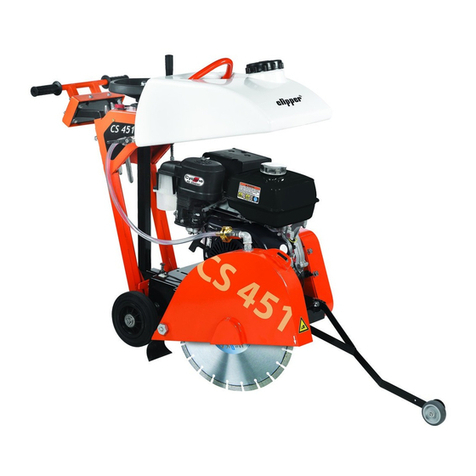
Norton
Norton CS 451 P13 Operating instructions and spare parts list
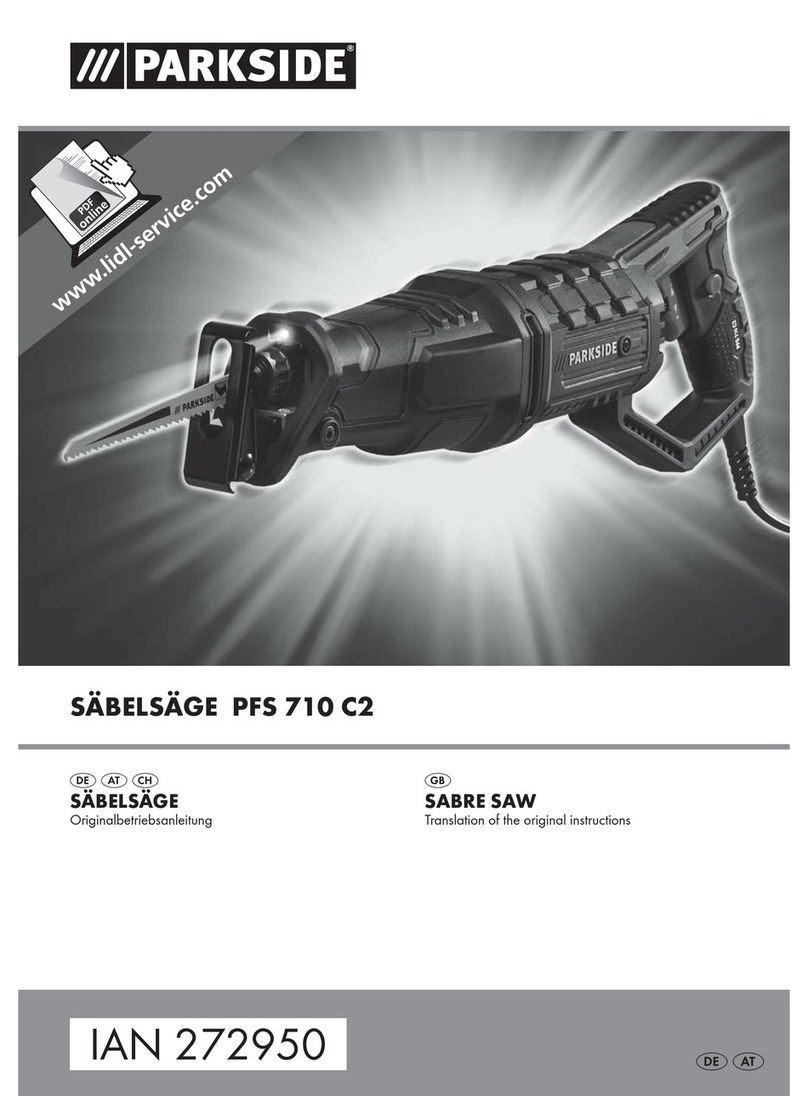
Parkside
Parkside PFS 710 C2 Translation of the original instructions

DoAll
DoAll c-530 nc Instruction & parts manual
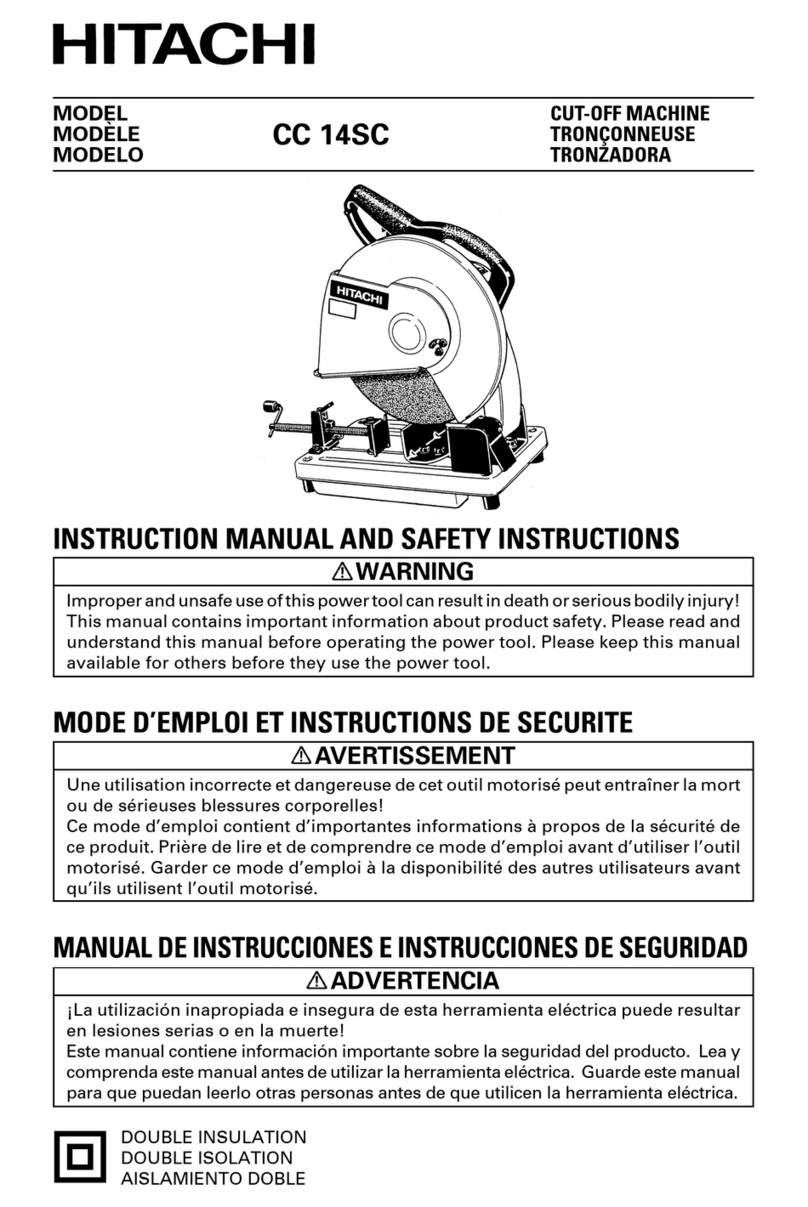
Hitachi
Hitachi CC 14SC Instruction manual and safety instructions
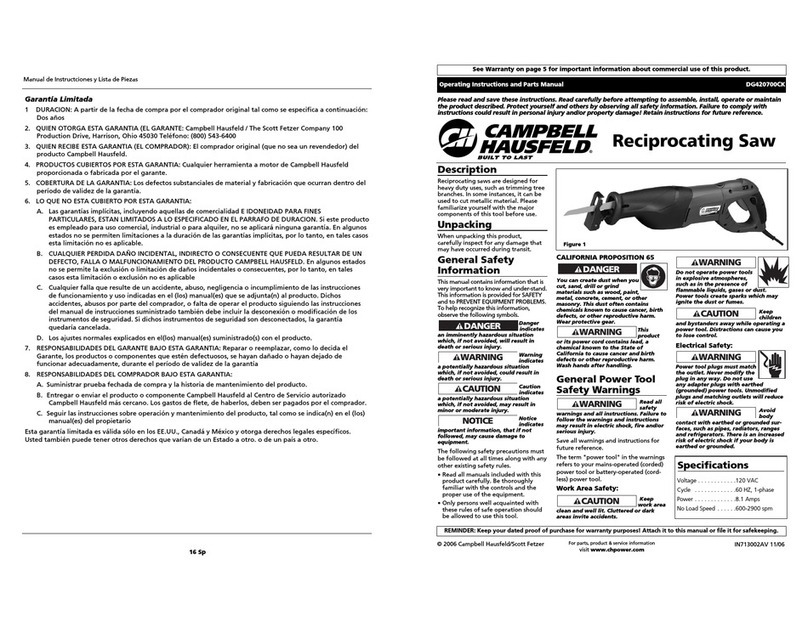
Campbell Hausfeld
Campbell Hausfeld DG420700CK Operating instructions and parts manual
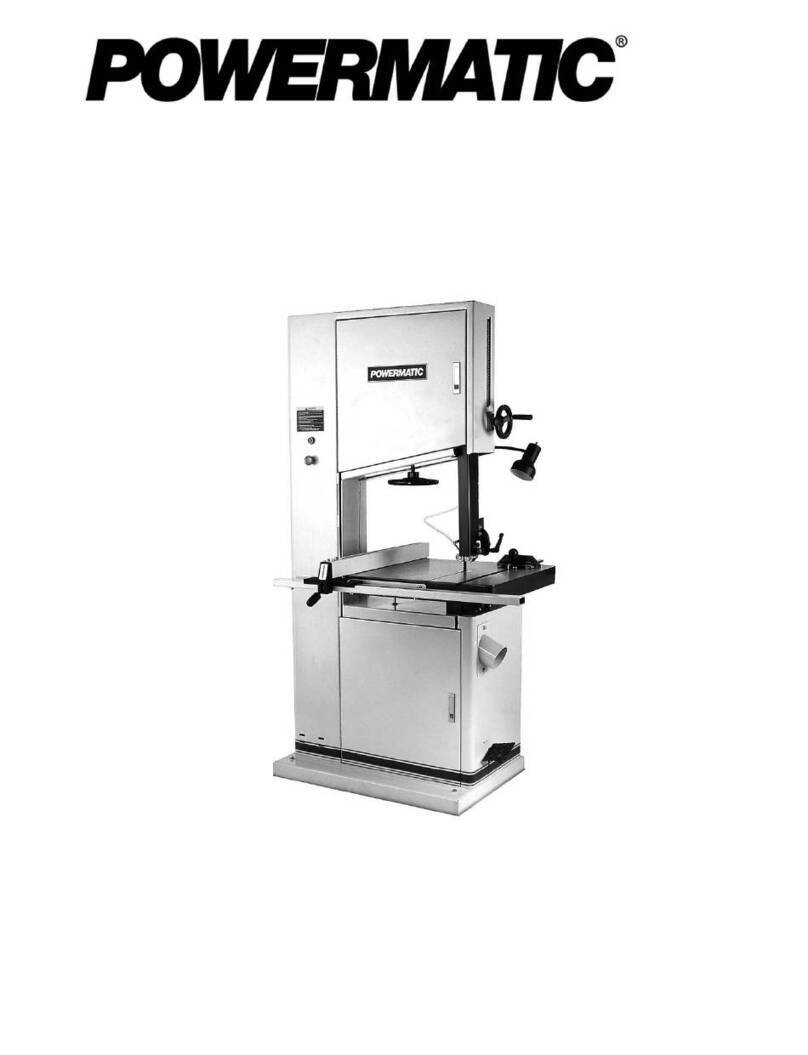
Powermatic
Powermatic 2415 Operating instructions and parts manual


